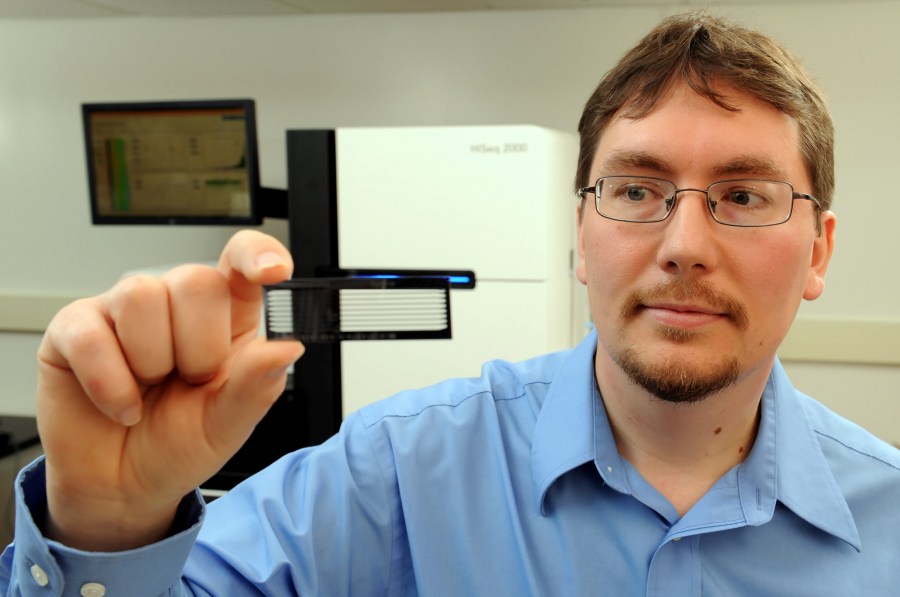
Travis Clark, Ph.D., manager of next generation sequencing in Vanderbilt’s Genome Sciences Resource, holds a “flow cell,” on which DNA fragments are loaded for reading by the new HiSeq 2000 sequencing machine (in background). (Photo by Joe Howell)
VUMC debuts ‘next generation’ DNA sequencers
Faster. Better. Cheaper.
That's the description of the “next generation” DNA sequencing available at Vanderbilt University Medical Center.
Since the first of the year, one cutting-edge sequencer, the Illumina HiSeq 2000, has been installed in a lab in the Preston Research Building, and another has been delivered.
More than 30 Vanderbilt investigators have submitted samples for sequencing by the machines, which are not much bigger than half-size refrigerators.
“The access to this technology allows them to do work that they wouldn't be able to do … to take the research to the next level,” said Travis Clark, Ph.D., manager of next generation sequencing in the new Genome Sciences Resource.
The Genome Sciences Resource brings the DNA Sequencing Facility, the Functional Genomics Shared Resource and the Genome Technology Core under one roof.
In addition to substantial ongoing institutional support, the resource receives funding from the National Institutes of Health (NIH) via the Vanderbilt-Ingram Cancer Center, the Vanderbilt Digestive Disease Research Center and the Vanderbilt Vision Research Center.
The resource is scheduled to move in mid-2012 to the ground floor of Medical Center North adjacent to the Flow Cytometry Core.
An $8.6 million federal stimulus grant Vanderbilt received last year is funding renovation and modernization of the space.
“One of the real strengths of Vanderbilt is the breadth and strength of our core facilities,” said Mark Magnuson, M.D., interim director of the Genome Sciences Resource.
“By making a strategic investment in next generation sequencing technology we will, without question, accelerate discoveries in both the basic and clinical sciences. This is something that is especially important for our personalized medicine initiative.”
Known for years for its expertise in genetic medicine, Vanderbilt recently made several major investments in next-generation sequencing. The first HiSeq 2000 and sample loading equipment, purchased by the university from San Diego-based Illumina Inc., for about $750,000, were installed in January.
In March, Alfred George, M.D., chief of the Vanderbilt Division of Genetic Medicine and former scientific director of the DNA Sequencing Facility, received a $515,000 grant from the NIH toward the purchase of a second HiSeq 2000. It arrived on April 5.
Another next-generation sequencing machine, the SOLiD 5500 System, has been purchased with a philanthropic grant and will be used by William Pao, M.D., Ph.D., director of Personalized Cancer Medicine at the Vanderbilt-Ingram Cancer Center. “The ability to determine comprehensive mutational profiles of cancers will be critical to the development of better therapies,” Pao said.
Technology like the HiSeq 2000 gives Vanderbilt scientists “unparalleled abilities to identify disease-relevant changes in genome composition, determine patterns of gene expression in a highly quantitative way, and understand how chromosomes are organized and regulated,” agreed William Tansey, Ph.D., interim chair of Cell & Developmental Biology.
“We are using the HiSeq to perform whole exome sequencing (sequencing every gene) in over 100 Amish individuals to discover variation related to dementia and successful aging,” said Jonathan Haines, Ph.D., director of the Vanderbilt Center for Human Genetics Research.
“We plan to sequence billions of DNA copies to examine epigenetic changes in animals, compare gene expression between sick and healthy animals, and discover new viruses by sequencing their entire genomes,” added Seth Bordenstein, Ph.D., assistant professor of Biological Sciences.
A decade ago, this work would have taken years to complete, Bordenstein said. Today, it can be accomplished in a matter of months and at a fraction of the cost. “HiSeq 2000 is one giant leap for the biological sciences.”













